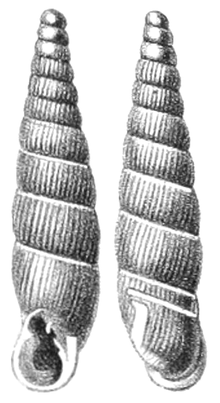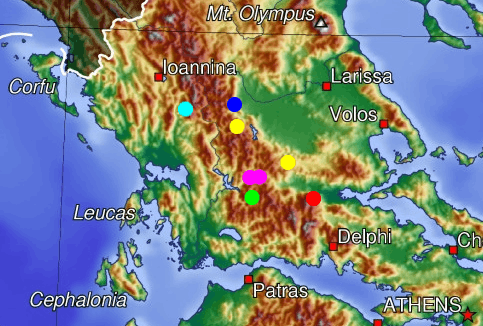Inchoatia haussknechti
Inchoatia haussknechti is a species of air-breathing land snail, a terrestrial pulmonate gastropod mollusk in the family Clausiliidae, the door snails.
| Inchoatia haussknechti | |
|---|---|
 | |
| two views of the shell of Inchoatia haussknechti haussknechti from its type description by Oskar Boettger | |
| Scientific classification | |
| Kingdom: | |
| Phylum: | |
| Class: | |
| (unranked): | clade Heterobranchia
clade Euthyneura clade Panpulmonata clade Eupulmonata clade Stylommatophora informal group Sigmurethra |
| Superfamily: | |
| Family: | |
| Subfamily: | Alopiinae |
| Tribe: | Medorini |
| Genus: | |
| Species: | I. haussknechti |
| Binomial name | |
| Inchoatia haussknechti (O. Boettger, 1886)[1] | |
| Synonyms | |
|
Clausilia (Albinaria) Haussknechti Boettger, 1886 | |
Description
The shell is dark horny brownish, very finely striated, slightly coarser at the cervix.[2] The shell has 9-11 whorls.[2] The cervix is with strong basal and dorsal keels and a basal forrow in between, also inside the aperture.[2] The columellaris is not very prominent, the frontal upper palatalis is short, basalis is short, subcolumellaris is visible in an oblique view.[2]
The width of the shell is 3-3.5 mm.[2] The height of the shell is 13–17 mm.[2]
Distribution
Inchoatia haussknechti is distributed in limestone areas from south Epirus to Central Greece.[2][3]

yellow dot = Inchoatia haussknechti haussknechti
red dot = Inchoatia haussknechti orina
violet dot = Inchoatia haussknechti alticola
dark blue dot = Inchoatia haussknechti hiltrudae
light blue dot = Inchoatia haussknechti refuga
Subspecies
According to the Gittenberger & Uit de Weerd (2009)[3] the species Inchoatia haussknechti include 6 subspecies:
- Inchoatia haussknechti haussknechti (O. Boettger, 1886)
- Inchoatia haussknechti alticola (Nordsieck, 1974)
- Inchoatia haussknechti hiltrudae (Nordsieck, 1974)
- Inchoatia haussknechti orina (Westerlund, 1894)
- Inchoatia haussknechti refuga (Westerlund, 1894)
- Inchoatia haussknechti semilaevis (O. Boettger, 1889)
Inchoatia haussknechti haussknechti
Synonyms include:[3]
- Sericata (Sericata) haussknechti haussknechti
- Carinigera (Carinigera) haussknechti haussknechti
- Albinaria haussknechti haussknechti
Diagnosis: The entire teleoconch is with sharp, mostly whitened riblets. The parietal side of the apertural border is not protruding. Lamella columellaris is shortly protruding into the aperture. Lamella parietalis is moderately long, i.e. reaching slightly further than the lamella spiralis. The lunella is prominent.[3]
Range: The type locality is Greece, Thessalia, Karditsa: northern side of the Voutsikaki Mts (= 25 km WSW of Karditsa).[1][3] The type locality ‘Gion Skala’, apparently a high, narrow passage, cut through the rocks at the northern side of the Voutsikaki Mountains, could be located on the basis of the detailed excursion report by Stussiner, in Boettger (1886: 47).[1][3] The disjunct range of this subspecies is built up by three populations in the eastern Pindos Mountains.[3]
Notes: The population that was discovered recently at an isolated limestone outcrop near Mesochori, is located 45 km SE of the type locality.[3] The Mount Oeta, where according to Nordsieck (1972,[4] 1974[5]) the same subspecies occurs (see Inchoatia haussknechti orina), is situated 35 km SE of Mesochori and 80 km SE of the Voutsikaki Mts. It should be investigated whether these disjunctions, which are quite extreme when compared with the distributional patterns of the other subspecies, are not correlated with any taxonomically relevant differentiation.[3]
Inchoatia haussknechti alticola
Synonyms include:[3]
- Carinigera haussknechti alticola Nordsieck, 1974 - pl. 3 fig. 9 (holotype)[5]
- Carinigera (Carinigera) haussknechti alticola
- Albinaria semilaevis alticola
Diagnosis: Initial teleoconch whorls with lengthened white papillae, without regular riblets; parietal side of the apertural border not protruding; lamella parietalis short; lamella columellaris (very) low; lunella rather prominent.[3]
Range: This subspecies is known from the Mt. Timfristos (= Veluchi) area, north of Karpenisi.[3] The type locality is 4 km north of Karpenisi, Mt. Timfristos ski resort, 1900 m alt.[3]
Initially (Nordsieck, 1972)[4] this form was not separated from Inchoatia haussknechti semilaevis.[3]
Inchoatia haussknechti hiltrudae
Synonyms include:[3]
- Carinigera haussknechti hiltrudae Nordsieck, 1974 - pl. 4 fig. 10 (holotype)[5]
- Carinigera (Carinigera) haussknechti hiltrudae
- Albinaria hiltrudae
Diagnosis: Initial teleoconch whorls with often whitened riblets, which become more irregular and are often not whitened on the lower whorls; parietal side of the apertural border usually protruding; lamella columellaris clearly protruding into the aperture; lamella parietalis moderately long, i.e. reaching slightly further than the lamella spiralis; lunella prominent.[3]
Range: This subspecies is only known from the type locality: Greece, Thessalia, Trikala: 1 km W of Pyli (= Pili), near the classical bridge, 300 m alt.[3]
Inchoatia haussknechti orina
Synonyms include:[3]
- Clausilia (Albinaria) orina Westerlund, 1894[6]
- Carinigera (Carinigera) haussknechti orina
- Albinaria haussknechti orina
Material.― Greece, Fthiotida/Fokida, Mt. Oiti (= Iti), c. FH1097 (but see ‘Range’).
Diagnosis.― See the notes.
Range: The type locality ‘Koraki Besa im Oetagebirge’ (Westerlund, 1894: 175) could not be located. The Mt Oeta is nowadays called Oiti or Iti Oros (situated 20 km SW of Lamia). Nordsieck (1974: 148)[5] suggested that ‘Koraki Besa’ refers to the Korax Mtn (= Korakas) in the Vardousia Mts (about 35 km SW of Lamia), c. 15 km SW of the Oiti Oros. The area should be visited to get more certainty.[3] The material examined by Gittenberger & Uit de Weerd (2009) is listed as: "Greece, Fthiotida/Fokida, Mt. Oiti (= Iti), c. FH1097".[3]
Neither a detailed description nor a figure is available, but a lectotype has been selected by Nordsieck (1972: 16).[3][4] Nordsieck (1972: 16; 1974: 148)[4][5] considered this taxon a synonym of the nominate subspecies, whereas Zilch (1981: 125)[7] and Nordsieck (2007: 48)[8] listed it as a subspecies, without adding more data.[3]
Inchoatia haussknechti refuga
Synonyms include:[3]
- Clausilia (Albinaria) refuga Westerlund, 1894[6]
- Sericata (Sericata) haussknechti refuga - Nordsieck (1972): plate 2, fig. 21 (lectotype).[4]
- Carinigera (Carinigera) haussknechti refuga
- Albinaria haussknechti refuga
Diagnosis: The entire teleoconch is with sharp, mostly whitened riblets. The parietal side of the apertural border is protruding. Lamella columellaris is shortly protruding into the aperture. The lower part of the lunella is obsolete.[3] The subspecies was characterized, with the designation of a lectotype, by Nordsieck (1972).[3][4]
Range: Only known from the type locality. ‘Katafiyi (800 m)’ and ‘Katafiyi (2000 m)’, mentioned by Nordsieck (1972),[4] refer to Katafigio (= Katafiyion) at the western foot of the Tschumerka Mts.[3]
Inchoatia haussknechti semilaevis
Synonyms include:[3]
- Clausilia (Albinaria) haussknechti var. semilaevis O. Boettger, 1889[9]
- Sericata (Sericata) haussknechti semilaevis - Nordsieck (1972): 16, plate 2, figure 20 (lectotype)[4]
- Carinigera (Carinigera) haussknechti semilaevis - Zilch (1981): 125, plate 12, figure 14 (lectotype).[7]
- Albinaria semilaevis semilaevis
Diagnosis: Only the initial whorls of the teleoconch and the cervical part with sharp, partly whitened riblets; parietal side of the apertural border not protruding; lamella columellaris shortly protruding into the aperture; lunella prominent.[3]
Range: The type locality of this subspecies is indicated in a somewhat misleading way because the Mt Veluchi (= Velouhi) or Mt Timfristos is situated a few km N of Karpenisi, where Inchoatia haussknechti alticola occurs, whereas “Kaljakuda” refers to Mt Kaliakouda, 16 km SSW of Karpenisi. The localities ‘Karpenission’ and ‘Timfristos-Geb. 13 km n. Karpenission’, cited for this subspecies by Nordsieck (1972),[4] should be transferred to Inchoatia haussknechti alticola, though only the latter record is repeated (in a slightly different wording) by Nordsieck (1974).[3][5]
References
This article incorporates CC-BY-3.0 text from reference [3] and public domain text from the reference.[2]
-

- "Species summary for Carinigera haussknechti". AnimalBase, last modified 14 February 2009, accessed 17 August 2010.
- Gittenberger E. & Uit de Weerd D. R. (2009). "Summarizing data on the Inchoatia taxa, including Inchoatia megdova bruggeni subspec. nov. (Gastropoda, Pulmonata, Clausiliidae)". Zoologische Mededelingen 83 http://www.zoologischemededelingen.nl/83/nr03/a08 Archived 2014-01-16 at the Wayback Machine
- Nordsieck H. (1972). "Zur Anatomie und Systematik der Clausilien, XI. Neue Formen und taxonomische Revision einiger Gruppen der Alopiinae". Archiv für Molluskenkunde 102: 1-51.
- Nordsieck H. (1974). "Zur Anatomie und Systematik der Clausilien, XV. Neue Clausilien der Balkan-Halbinsel (mit taxonomischer Revision einiger Gruppen der Alopiinae und Baleinae)". Archiv für Molluskenkunde 104: 123-170.
- Westerlund C. A. (1894). "Specilegium malacologicum". Nachrichtsblatt der Deutschen Malakozoologischen Gesellschaft 26: 163-177.
- Zilch A. (1981). "Die Typen und Typoide des Natur-Museums Senckenberg, 65: Mollusca: Clausiliidae (6): Alopiinae (4): Montenegrinini". Archiv für Molluskenkunde 111: 123-145.
- Nordsieck H. (2007). Worldwide door snails (Clausiliidae), recent and fossil. 1-214. ConchBooks, Hackenheim.
- Boettger O. (1889). "Ein Paar neue Fundorte griechischer Landschnecken". Nachrichtsblatt der Deutschen Malakozoologischen Gesellschaft 21: 23-26.